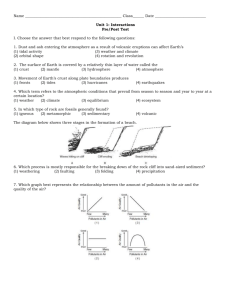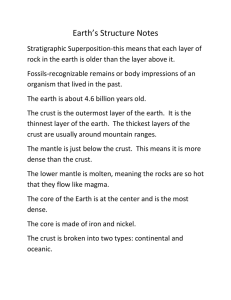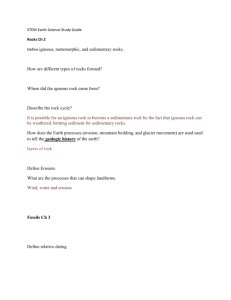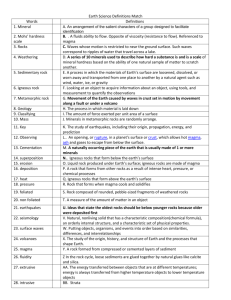EARTH SCIENCE Final Exam 2013 Answers
advertisement
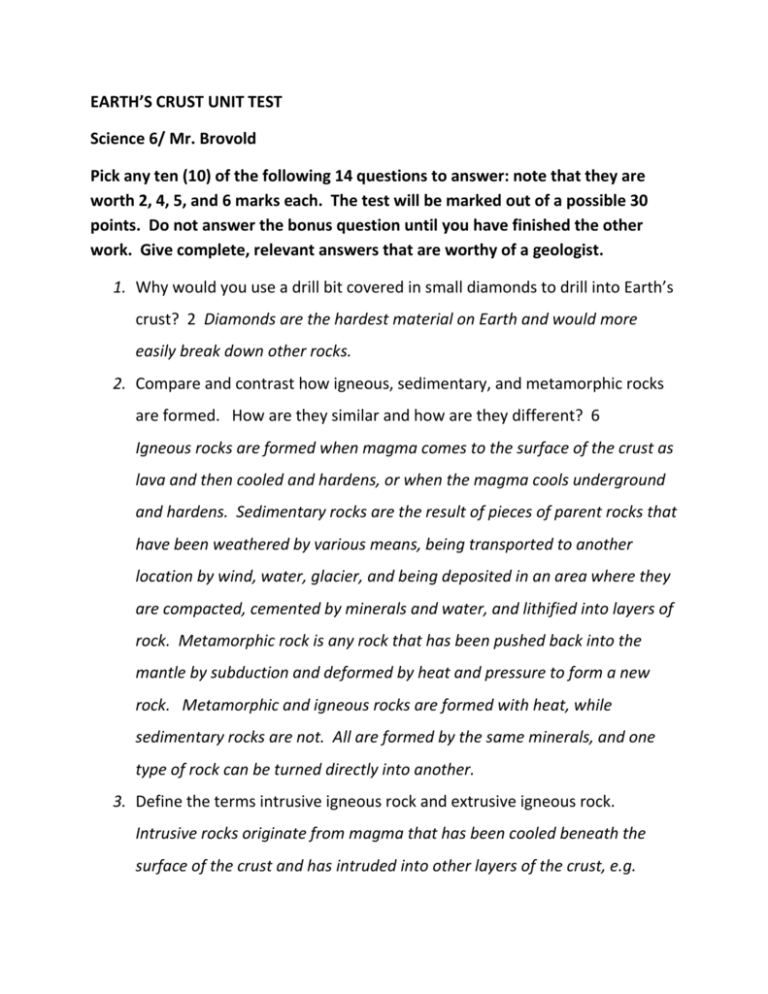
EARTH’S CRUST UNIT TEST Science 6/ Mr. Brovold Pick any ten (10) of the following 14 questions to answer: note that they are worth 2, 4, 5, and 6 marks each. The test will be marked out of a possible 30 points. Do not answer the bonus question until you have finished the other work. Give complete, relevant answers that are worthy of a geologist. 1. Why would you use a drill bit covered in small diamonds to drill into Earth’s crust? 2 Diamonds are the hardest material on Earth and would more easily break down other rocks. 2. Compare and contrast how igneous, sedimentary, and metamorphic rocks are formed. How are they similar and how are they different? 6 Igneous rocks are formed when magma comes to the surface of the crust as lava and then cooled and hardens, or when the magma cools underground and hardens. Sedimentary rocks are the result of pieces of parent rocks that have been weathered by various means, being transported to another location by wind, water, glacier, and being deposited in an area where they are compacted, cemented by minerals and water, and lithified into layers of rock. Metamorphic rock is any rock that has been pushed back into the mantle by subduction and deformed by heat and pressure to form a new rock. Metamorphic and igneous rocks are formed with heat, while sedimentary rocks are not. All are formed by the same minerals, and one type of rock can be turned directly into another. 3. Define the terms intrusive igneous rock and extrusive igneous rock. Intrusive rocks originate from magma that has been cooled beneath the surface of the crust and has intruded into other layers of the crust, e.g. granite. Extrusive rocks come from magma that has been extruded onto the surface of the Earth as lava and cooled into rock, e.g. basalt. 4. Give natural examples of these terms: biological mechanical weathering: Tree roots move into the cracks between rocks and expand during growth, forcing apart pieces of rock until they break off. biological chemical weathering 4 Lichens are plants that produce their own carbonic acid to break down rocks into minerals to use as nutrients. 5. How could water, in any state, be involved in both chemical and mechanical weathering? 4 Rainwater combines with carbon in the air to produce carbonic acid, which can break down some rocks. Water can break down rocks by movement of rock material in streams, by glacial abrasion, and by frost wedging, where ice in cracks between rocks will expand and break off pieces of rock. 6. What is erosion, and how is it different from weathering? 2 Erosion is the transportation of weathered material to other locations for deposition. It can occur in moving water, by wind, by glaciers, and by gravity. Weathering is the actual breaking down of parent rocks into smaller pieces. 7. List the four types of erosion, and give an example of each. 4 Wind carries particles of sand, silt, and clay to other locations (dunes), gravity causes rock material to fall to lower areas (landslides, avalanches), glaciers move attached weathered rock down glacial valleys (moraine); water moves SSC and boulders downstream for deposition (to form sedimentary layers). 8. Using the Rock Cycle, explain how: An igneous rock can be broken down and then become an igneous rock again. An igneous rock is weathered into smaller pieces, eroded to a deposition area, and is gradually lithified into sedimentary rock on the ocean floor. The rock is then subducted into the mantle, where it is melted back into magma. Eventually, the magma is extruded as lava, or cools beneath the surface. 9. What causes sea-floor spreading? 4 Tectonic plates are forced apart by the pressure of rising magma in the mantle. The magma is extruded onto the plates and fills the gap between them, creating a mid-ocean ridge of cooled lava. 10.Why is ocean crust so much younger than continental crust? Where would you find the oldest and youngest ocean crust? 4 Continental crust is thinner and more dense than ocean crust, causing the ocean crust to subduct beneath the continental crust. The ocean crust is in a continuous state of destruction and replacement at the mid-ocean ridges. You will find the youngest crust as you get nearer to the mid-ocean ridges, whereas the oldest crust is usually found at the subduction zones. 11.Which part of a stream flow or glacier moves the fastest, and why? The middle top of streams or glaciers flows the fastest, since this area is the furthest away from the points of friction (sides and bottom). 12.What happens where continental crust meets ocean crust? What is a subduction zone? 4 The ocean plate will be driven by the force of seafloor spreading under the continental plate because it is more dense and thinner (subduction). The ocean plate will be driven into the mantle, where it will become deformed into metamorphic rock or melted into magma. 13.Mountains are formed in several different ways. Describe two of these ways in detail. 6 Accretion: layers of sedimentary rock formed by deposition of material from the continental crust are scraped off the ocean plate during the subduction of the plate and form part of the continental crust as mountains (e.g. Rocky Mountains). Continental plates colliding: two continental plates that collide may not subduct, but buckle against each other, causing uplift of crust to form mountains (e.g. Himalayas). Mountains are built by the accumulation of cooled lava and ash erupted by a volcano, sometimes in a cone shape (Mount Baker, Mount Fuji). 14.The movements and locations of tectonic plates are tracked continually by seismologists, who record about 300 minor earthquakes per year in BC. What could it mean when no readings occur along a plate boundary for several years? 2 It could mean that the plates are snagged against each other and are gathering more elastic energy without the gradual release of small earthquakes. It could indicate a powerful earthquake in the future. 15.How would scientists know that Richmond and Delta are made from river sediment? They would examine the type of rock material and compare it with rocks found further up the Fraser River, and the ways in which the rocks have been weathered and deposited by the time they get to Richmond. 16.What causes a tsunami? Why do tsunamis grow taller as they approach land? 4 A tsunami is caused by the movement of a tectonic plate and the energy released by an earthquake, or an underwater landslide, or a large meteorite, displacing vast amounts of ocean water. As the wave gets into shallower water near land, the beach creates friction with the bottom of the wave, directing energy to the top of the wave as it overtakes the bottom. The wave will increase in height several times and wash onto shore. 17.What is pyroclastic flow, what causes it, and why is it dangerous? 5 Pyroclastic flow is extruded gases and lava from a violent eruption, up to two km in the air. As the rock and ash fall to the surface, it is redirected outward across the adjacent area at speeds of up to 200 km/h. The hot gases and ash can level forests and kill anything in its path in a wide range of area, depending on the strength of the eruption. 18.What are some of the things people do to create more weathering? 4 People use fossil fuels which leave carbon in the air, which combines with rainfall to make carbonic acid, which weathers some types of rocks. People remove vegetation from forests, which exposes topsoil to weathering by water and wind. BONUS QUESTIONS: 10 marks Pick ONE only. 1. Two streams are running on the same slope, parallel to each other. There are no obstructions above the surface in either stream. Stream A is two metres wide, and Stream B is one metre wide. Both streams empty the same amount of water per minute into a quiet lake at the same location. Compare and contrast the two streams for these variables, using technical terms as much as possible: 1. Water velocity (flow): Since the mass is the same, B would have a stronger current because the water is moving through a smaller area. 2. The relative size of weathered rock material that is being eroded: B would have a greater competence because the force of the stronger current is able to carry larger pieces in the stream flow. 3. The rock material that you might find on each stream bed: You would find more fine sediment (SSC) on the surface of the stream bed in A because of the lesser current; you would also find more SSC on the banks of A. 4. The weathering that might take place on each stream bed: A would create more weathering with larger pieces of rocks because of the greater force of the stronger current 5. How the material in the water is deposited into the lake: The energy in the current in both streams entering the lake would disperse in the quieter water, but the sediment in B would have more momentum and would be deposited further from the mouth of the stream than A, due to the greater force of its current. You may use a neat, well-labelled diagram to help you answer this question. 2. Explain weathering and erosion in a stream in connection with Newton’s first two laws of motion (inertia and acceleration). Give a detailed answer using technical terms as much as possible. Identify the forces at work on the water and the rock material. The rocks and other material on the stream bed have inertia, that is, they are at rest until an external unbalanced force acts upon them. In this case, the force is the product of the mass of the water times the velocity of the stream’s flow, and work will be done if the rocks are moved in the direction of the force. The larger the rock, then the greater the inertia. Other factors that resist motion are gravitational energy and the friction caused by the texture of the stream bed – the combination of these factors increase the amount of force necessary to move the rocks and erode the material. One indicator of the amount of force in a stream is the maximum size of the rock particle that the water flow is able to keep suspended (competence). If the stream flow is heavy enough to move boulders and rocks along the stream bed, then the boulders will transfer the energy of their movement to other rocks, breaking them in the process, and creating smaller rocks that require lesser amounts to force to erode them. The potential amount of material that the stream may carry is called the capacity. If the force of the stream’s flow is reduced as the result of less mass or velocity, then some of the pieces will be deposited on the stream bed 3. Two different rocks are the same colour, and are translucent. What other tests could you perform to help you identify the rocks? The rocks have the same colour and clarity; therefore other tests are required to identify the rocks. Moh’s Scale could be applied by using materials of various hardness to match with the samples. A test for light reflectivity would provide a degree of lustre in categories that include satin, glossy, and metallic. Iron filings could be applied to test for magnetism, although magnetite isn’t translucent. A magnet could be applied to test for iron. Crystal structure and texture could be compared. Applying hydrochloric acid would create Co2 gas if calcite is present in the rock. Testing for cleavage would tell whether the rock fractures, forms cubes, or splits into parallel sheets. You could measure (m/v = d) the relative density for each rock and compare with known rocks.
